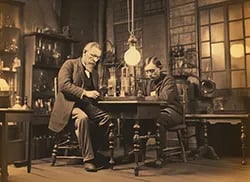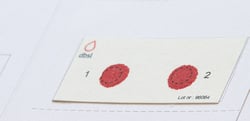Share this
capillary blood collection: a journey through history
by Neoteryx Microsampling on Nov 8, 2017 5:28:00 AM
The intricacies of our circulatory system have long fascinated medical practitioners and researchers. Capillaries - the tiny blood vessels connecting arteries and veins - play an essential role within this system. When the finger's tip is pricked, the blood emerging is sourced from these capillaries, marking the essence of capillary blood sampling.
The Ancient Practice of Bloodletting
.jpg?width=250&height=169&name=Surgical_tools%2c_5th_century_BC%2c_Greece_(reconstruction).jpg) Dating back to the time of Hippocrates in the 5th century BC, blood extraction has held significance in medical practice. For centuries, bloodletting, considered a "heroic treatment," was employed to purge "bad humors" believed to be the culprits behind illnesses. This therapy, though intended to be life-saving, often proved detrimental. Leeches were commonly used, indicating the rudimentary nature of early blood sampling.
Dating back to the time of Hippocrates in the 5th century BC, blood extraction has held significance in medical practice. For centuries, bloodletting, considered a "heroic treatment," was employed to purge "bad humors" believed to be the culprits behind illnesses. This therapy, though intended to be life-saving, often proved detrimental. Leeches were commonly used, indicating the rudimentary nature of early blood sampling.
Discovery of the Circulatory System
 Sir William Harvey, an English physician in the early 17th century, provided a groundbreaking revelation by identifying the circulatory system. Interestingly, capillaries, the critical bridges between arteries and veins, weren't discovered during his lifetime.
Sir William Harvey, an English physician in the early 17th century, provided a groundbreaking revelation by identifying the circulatory system. Interestingly, capillaries, the critical bridges between arteries and veins, weren't discovered during his lifetime.
Transition to Diagnostic Blood Sampling
 By the late 19th century, the focus shifted from therapeutic blood drawing to diagnostic examination. Bloodletting, with its historical significance, gradually vanished as the scientific community began to understand blood's vast diagnostic potential. In the subsequent years, blood became the epicenter of numerous studies, revealing the functions of countless proteins, lipids, and carbohydrates. Advanced microscopic and submicroscopic evaluations of blood cells have since paved the way for treating numerous diseases.
By the late 19th century, the focus shifted from therapeutic blood drawing to diagnostic examination. Bloodletting, with its historical significance, gradually vanished as the scientific community began to understand blood's vast diagnostic potential. In the subsequent years, blood became the epicenter of numerous studies, revealing the functions of countless proteins, lipids, and carbohydrates. Advanced microscopic and submicroscopic evaluations of blood cells have since paved the way for treating numerous diseases.
The Advent of Venipuncture and its Limitations
 The traditional method of obtaining blood, venipuncture, involves drawing 5 to 10 ml of blood by piercing a vein with a needle. Although effective, this method posed a risk. In cases where numerous tests were ordered, patients could develop anemia due to excessive blood extraction.
The traditional method of obtaining blood, venipuncture, involves drawing 5 to 10 ml of blood by piercing a vein with a needle. Although effective, this method posed a risk. In cases where numerous tests were ordered, patients could develop anemia due to excessive blood extraction.
Revolutionizing Blood Sampling: Dr. Robert Guthrie's Contribution
 1962 marked a transformative year in blood sampling. Dr. Robert Guthrie modified the test for phenylketonuria, a congenital disease. Early detection post-birth and prompt treatment could prevent the impending mental retardation associated with the disease. The challenge, however, was extracting blood from every newborn. Dr. Guthrie ingeniously developed a test requiring just a drop of dried blood on filter paper, obtainable by a single prick on the baby's heel.
1962 marked a transformative year in blood sampling. Dr. Robert Guthrie modified the test for phenylketonuria, a congenital disease. Early detection post-birth and prompt treatment could prevent the impending mental retardation associated with the disease. The challenge, however, was extracting blood from every newborn. Dr. Guthrie ingeniously developed a test requiring just a drop of dried blood on filter paper, obtainable by a single prick on the baby's heel.
The Modern Era of Capillary Blood Sampling
 With today's technological advancements, we can conduct hundreds of tests using just a single drop of blood. The days of painful vein searches and the associated risks of iatrogenic anemia are behind us. Capillary blood sampling, which is less painful, has revolutionized patient-centric care. The ability for patients to self-sample eliminates the need for a professional, thus reducing costs. As home-based testing becomes more common, prioritizing patient convenience defines modern medical practice. We've come a long way from leeches.
With today's technological advancements, we can conduct hundreds of tests using just a single drop of blood. The days of painful vein searches and the associated risks of iatrogenic anemia are behind us. Capillary blood sampling, which is less painful, has revolutionized patient-centric care. The ability for patients to self-sample eliminates the need for a professional, thus reducing costs. As home-based testing becomes more common, prioritizing patient convenience defines modern medical practice. We've come a long way from leeches.
Share this
- Microsampling (206)
- Research, Remote Research (119)
- Venipuncture Alternative (105)
- Clinical Trials, Clinical Research (83)
- Mitra® Device (73)
- Therapeutic Drug Monitoring, TDM (51)
- Dried Blood Spot, DBS (39)
- Biomonitoring, Health, Wellness (30)
- Infectious Disease, Vaccines, COVID-19 (24)
- Blood Microsampling, Serology (23)
- Omics, Multi-Omics (21)
- Decentralized Clinical Trial (DCT) (20)
- Specimen Collection (18)
- Toxicology, Doping, Drug/Alcohol Monitoring, PEth (17)
- Skin Microsampling, Microbiopsy (14)
- hemaPEN® Device (13)
- Preclinical Research, Animal Studies (12)
- Pharmaceuticals, Drug Development (9)
- Harpera Device (7)
- Industry News, Microsampling News (5)
- Antibodies, MAbs (3)
- Company Press Release, Product Press Release (3)
- Environmental Toxins, Exposures (1)
- July 2025 (1)
- May 2025 (1)
- April 2025 (2)
- December 2024 (2)
- November 2024 (1)
- October 2024 (3)
- September 2024 (1)
- June 2024 (1)
- May 2024 (1)
- April 2024 (4)
- March 2024 (1)
- February 2024 (2)
- January 2024 (4)
- December 2023 (3)
- November 2023 (3)
- October 2023 (3)
- September 2023 (3)
- July 2023 (3)
- June 2023 (2)
- April 2023 (2)
- March 2023 (2)
- February 2023 (2)
- January 2023 (3)
- December 2022 (2)
- November 2022 (3)
- October 2022 (4)
- September 2022 (3)
- August 2022 (5)
- July 2022 (2)
- June 2022 (2)
- May 2022 (4)
- April 2022 (3)
- March 2022 (3)
- February 2022 (4)
- January 2022 (5)
- December 2021 (3)
- November 2021 (5)
- October 2021 (3)
- September 2021 (3)
- August 2021 (4)
- July 2021 (4)
- June 2021 (4)
- May 2021 (4)
- April 2021 (3)
- March 2021 (5)
- February 2021 (4)
- January 2021 (4)
- December 2020 (3)
- November 2020 (5)
- October 2020 (4)
- September 2020 (3)
- August 2020 (3)
- July 2020 (6)
- June 2020 (4)
- May 2020 (4)
- April 2020 (3)
- March 2020 (6)
- February 2020 (3)
- January 2020 (4)
- December 2019 (5)
- November 2019 (4)
- October 2019 (2)
- September 2019 (4)
- August 2019 (4)
- July 2019 (3)
- June 2019 (7)
- May 2019 (6)
- April 2019 (5)
- March 2019 (6)
- February 2019 (5)
- January 2019 (8)
- December 2018 (3)
- November 2018 (4)
- October 2018 (7)
- September 2018 (6)
- August 2018 (5)
- July 2018 (8)
- June 2018 (6)
- May 2018 (5)
- April 2018 (6)
- March 2018 (4)
- February 2018 (6)
- January 2018 (4)
- December 2017 (2)
- November 2017 (3)
- October 2017 (2)
- September 2017 (4)
- August 2017 (2)
- July 2017 (4)
- June 2017 (5)
- May 2017 (6)
- April 2017 (6)
- March 2017 (5)
- February 2017 (4)
- January 2017 (1)
- July 2016 (3)
- May 2016 (1)
- April 2016 (2)



No Comments Yet
Let us know what you think